






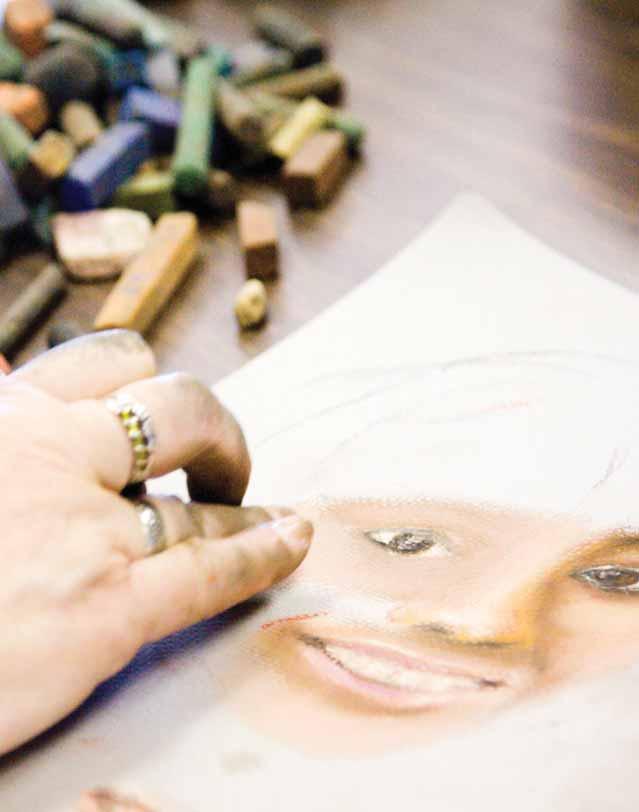



We’re coming up on the Season of Lists— Christmas gift lists and New Year’s resolution lists. But before these two holidays comes Thanksgiving. And so topping the list of lists should be a list of things we’re thankful for. This year my “things I’m thankful for” list starts with this picture.
When I first found the photo, my eyes locked on the table. The day before my brother-in-law had discovered the child’s table in the attic of my parents’ home. I assumed the little table was long gone and seeing it again was like being reunited with an old friend. It was a delight to recall my childhood as I looked at this picture. But I also realized that when I gently nudge the memories a side, the past is the soil in which my 2011 thanksgiving list is growing.
Two sisters… I’m thankful for my siblings—for the sister I grew up with (pictured left) and the brothersand sisters-in-law I belong to via marriage. Sibling relationships are sometimes complicated, but these friendships can also enrich our lives in one-of-a-kind ways.
In addition to my needs, I'm blessed with a long list of things that I simply want. Many people in the world can't say this.
“ “

Connie Faber Editor
Celebrate a birthday… I’m thankful for celebrations. Celebrations provide occasions to affirm one another and to express gratitude to those who enhance our lives. Being the honored guest at a birthday, baptism, wedding or anniversary party tells us that we matter to the people around us.
At their home… I’m thankful that my basic needs are met, that I’ve always had what I need—a warm home, plenty to eat and clothes to wear. I’m grateful that these essentials and other basic needs are taken care of—jobs, health care, education, personal and community safety, etc.
With gifts piled on a small red wooden table. In addition to my needs, I am also blessed with a long list of things that I simply want. Many people in the world can’t say this.
I’m thankful for the things that this picture suggests but doesn’t show. Topping that list is my parents. Neither of my parents is in this picture, but I know they were there; they were always there. I’m thankful for my dad and mom and that a love for Christ and his church is part of who they are. I’m grateful that my family history is filled with more people who put their faith in God than those who didn’t.
So between today and Thanksgiving I invite you to look closely at a favorite photograph. The first glance may take you on a trip down memory lane. But I hope the second look reveals a list of things for which you offer God a prayer of thanksgiving.









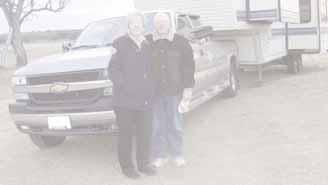





Tim Geddert

Amoving song played frequently on Christian radio says: “I’ve seen miracles just happen, silent prayers get answers, broken hearts become brand new: That’s what faith can do!” (Kutless) The lyrics speak about new beginnings after falling, about mountains moving, hope never ending, broken hearts becoming brand new.
It is beautifully Christian if the singer and songwriter are implying that God does miracles, gives the new beginnings, moves mountains, restores hope and mends broken hearts. But that needs to be assumed. The lyrics say none of these things, never mention God or Jesus, never credit the miracles to God.
The lyrics actually talk about what we do. We find the strength to rise; we make a new beginning; we are stronger than we think. The lyrics say that dreams move mountains; that if we need to try harder, we overcome the odds and miracles just happen!
But music is poetry; it’s evocative; it doesn’t have to say everything. So I will make lots of assumptions about the author’s meaning—that the “silent prayers” are prayers to the God of the universe, through Jesus Christ—that the miracles do not “just happen” but are God’s gifts that we gladly receive but cannot presume upon or conjure up ourselves—that God is the one who mends hearts and lifts the fallen.
And the biggest assumption I will make is that the song got the wrong title. It is not about what faith can do, but about what God can do! We sometimes imagine the key unlocking divine power is the quality of our faith or the eloquence or persistence of our prayers. And when no miracle happens, we diagnose the problem: Our faith wavered. We stopped praying too soon. There was sin in our lives. We failed to act as if the prayer were already answered. Soon we are competing to be the best pray-ers around.
How different the teaching of Matthew 6:1-18. We do not give alms, nor pray, nor fast so as to impress other people—that is the main lesson. And then the part often missed: We don’t pray to impress God either. God already knows our needs. God does not need to hear us babble on like pagans do.
The Lord’s Prayer is the model—direct, succinct, honoring God first, expressing dependence on God for everything in life (daily provision; forgiveness of sin, spiritual strength). Prayer neither manipulates God nor measures our spirituality. Prayer is laying our needs before a loving Father who knows and cares. We trust God; we do not trust in our strength or our faith or our prayer techniques.
I want to make all the right assumptions so that when I again hear that moving song by Kutless, I hear not what the poetic words of the song say but what the Bible actually says about how miracles happen.
Tim Geddert is professor of New Testament at Fresno Pacific Biblical Seminary, Fresno, Calif.
“Your Father knows what you need before you ask him....” ~ Matt.6:8

October / November 2011
Volume 75 • Number 5
Connie Faber EDITOR
Myra Holmes ASSISTANT EDITOR
Shelley Plett GRAPHIC DESIGNER
Darcie Jackson Photography COVER PHOTO
The Christian Leader (ISSN 0009-5149) is a gathering place for the people, passions and mission of U.S Mennonite Brethren. The Christian Leader is published bimonthly by the U.S. Conference of Mennonite Brethren Churches. However, the opinions expressed here are not necessarily those of the church as a whole.
COPYRIGHT The articles printed in the Christian Leader are owned by the CL or by the author and may not be reprinted without permission. Unless noted, Scripture quotations are from the New International Version.
READER PARTICIPATION Letters to the editor should be 300 words or less and on one subject. Letters must be signed and include the writer’s city and state. Letters will be edited for clarity, appropriateness and length. Letters will be published, as space allows, unless marked, “Not for publication.” Readers interested in contributing essays for In My Humble Opinion and First Person should contact the editor. Freelance article submissions are welcome; a SASE must accompany articles.
SUBSCRIPTIONS $10 for six issues and $20 for 12 issues ($15, $30 in Canada; all other countries $25 for six issues); $1.50 per copy
CORRESPONDENCE: All correspondence, including subscription questions and address updates, should be addressed to Christian Leader Box 155, 107 N. Main, Hillsboro, KS 67063-0155 Phone: 620.947.5543
E-mail: christianleader@usmb.org
MEMBERSHIP The Christian Leader is a member of the Evangelical Press Association and Meetinghouse, an association of Mennonite and Brethren in Christ editors.
POSTMASTER Send address changes to Christian Leader, Box 155, Hillsboro, KS 67063. Periodicals postage paid at Hillsboro, Kansas.
The Christian Leader is published by

U.S. Conference of MB Churches

Ed Boschman USMB Executive Director ebed@usmb.org
Three times in recent weeks, in three different states, a pastor has shared with me a new or renewed commitment to our U.S.
Mennonite Brethren Conference. This comes from a growing understanding that community and partnership matter and that collaborating as a national family of churches provides us with the opportunity to have greater life transforming kingdom impact.
This is a huge encouragement to me. It means that the mission statement that we endorsed four years ago to clarify our reason for being is understandable, practical, doable and increasingly affirmed. When our USMB Leadership Board and staff were prayerfully discerning clarity for our national mission, we gathered and compared the mission statements from all our districts and partner agencies. We discovered a common theme—the desire to see people invited into a faith-follow relationship with our Lord.
Our mission statement declares: “We partner as one family, serving one Lord, on one mission, for the transformation of individuals, families and communities.” We believe that loving God with heart, soul, mind and strength and our neighbor as ourselves translates to faithfully living as increasingly obedient followers of Jesus and to making disciples. One accurate measure of our faithfulness to Jesus lies in our individual and collaborative effectiveness in seeing newly transformed lives among us.
Our spiritual family movement was born 150 years ago in the context of what some of today’s writers call “missional.” Now that we live in a postChristian secular context, it is more important than ever that we live intentionally and relationally on mission in our own neighborhoods and among the pre-Christians we encounter in our lives. The more we develop a self understanding and reputation of being authentic, reproducing followers of Jesus, the better the kingdom of Jesus is served.
With regard to the structures of our family it seems that in a general way we agree that our district and national conferences matter, and that we are on a good and right track. This comes at a time when it is broadly reported that denominations have fallen on hard times (Mark Vincent of Design Group International in “Depth Perception,” May 31, 2011).
If our conference is in part held together by a committed covenantal relationship, it begs the question of how in practical terms we value and support what we hold in common. Are we shoulder to shoulder in our commitment and support to both our colleges and our seminary? To both MB Mission and Mission USA? To both our district and national leadership and service initiatives and to our local church ministries?
Perhaps because I believe that conferences must serve the agencies in their purview, something else Vincent wrote in his article stopped me cold. “Consider any covenant relationship. They disintegrate when one or more of the partners changes their theme song from “How may I serve you?” to “What’s in it for me?” Before long nothing is held in common except selfishness and the other partner is treated as hindering ballast.” Oh my goodness! Our conference reality is that our various partner ministries are rather independent in design and function. So I ask myself if that is what we appear to be to each other? Hindering ballast? Inasmuch as that is true, we need to pursue repentance and healing, and I will be first in line.
There are times when I wonder whether our national conference is considered evenhandedly and also whether we give appropriate deference to our ministry partners. My commitment is to do whatever I can to serve our one family and to lead our national ministry team, for the kingdom’s sake, to do the same. We all have chosen one and the same Lord. Let’s stay on his mission together.
If our conference is in part held together by a committed covenantal relationship, it begs the question of how in practical terms we value and support what we hold in common.
Michelle Welch
There are several Mennonite Brethren churches in the Central Valley of California. I know they are out there, but until recently I didn’t know how to connect the dots between them, to feel connected to a sister church. The story begins late one Monday afternoon when the phone rang in the office of Heritage Bible Church in Bakersfield, Calif. HBC member Deb Roney was calling to say that Susan* needed help.
Susan and her children are relatively new to our church family. Susan’s 13-year-old daughter, Anna, had suffered a severe injury months earlier in a motorcycle accident. Anna had endured a series of surgical procedures at Valley Children’s Hospital (VCH) in Madera, Calif., to save her foot. Susan expected this latest visit to VCH to be a routine one to remove a cast and inspect the surgical site. But the exam had revealed infection and the doctor wanted Anna to immediately check in to the hospital for more corrective surgery and antibiotics. Neither Anna or Susan was prepared for this disappointing news.
Mother and daughter had traveled that morning the 113 miles from Bakersfield to VCH for the oneday visit. When they learned of this latest setback they scrambled to make arrangements to stay. Susan had learned to be resourceful during her many visits at VCH, and she figured she could sleep on a chair in Anna’s hospital room and eat one meal a day to make her dollars stretch. But then Deb Roney learned of their circumstances and called me to see what could be done.
That Monday afternoon and evening I tried to contact Susan, not knowing Susan’s cell phone battery had run out of charge, and getting a busy signal every time I tried the hospital room phone. Tuesday morning the Spirit continued to nudge me to find a solution for Susan. Our senior pastor was on vacation so I contacted Elder Board member Vernon Reimer. Vernon contacted Louie Elrich of the
Shepherding Committee who agreed that the church could authorize an expenditure from our benevolence fund. Now the only problem was getting the money to Susan.
I couldn’t leave work to drive to Madera myself so I looked in the Pacific District Conference directory and found what I guessed was the closest church to Valley Children’s. Fresno’s geography is clearly not my forte because I called The Grove Community Church. Lowell Ens answered the phone. I explained the situation to Lowell and to my relief and delight he promptly agreed to purchase a gift card to deliver to Susan at the hospital, a 30-minute drive away.
Early Tuesday afternoon a message arrived in the HBC office from Susan thanking the church for sending her not only assistance but a visit from a very kind man and his two daughters. Apparently Lowell chose to make this impromptu visit a teachable moment for his girls. The three of them visited Susan and Anna, prayed with them and offered their assistance too. It was a very welcome and encouraging moment in Susan and Anna’s day.
The truth is, it was stepping out of my “comfort zone” to call on people I did not know to solve the problem of delivering help into the hands of a stranded sister in Christ. But when relief was provided, it was a sweet moment indeed as the body of Christ came together, though 100-plus miles apart, to meet the need of this family.
* We are using a pseudonym in consideration of privacy.
Michelle Welch, while a little geographicallychallenged, is Office Administrator to the pastoral staff at Heritage Bible Church. She is married 32 years to Mark, and they have four adult children, three grandchildren, one small dog and a Garmin navigation system.


The U.S. Conference of Mennonite Brethren Churches (USCMBC) has filled two new part-time staff positions and one vacancy.
Aleksandr Borisov, a Mennonite Brethren pastor from Spokane, Wash., began work Aug. 15 as the Slavic ministries director, a new position made possible by a partnership of five MB entities. Derk Madden, a Mennonite Brethren pastor from Collinsville, Okla., began working Sept. 15 as the director of development, a position created last spring by the USCMBC Leadership Board.



The addition of a part-time Slavic ministries director is made possible by a unique partnership between USCMBC, the Pacific District Conference, the Central District Conference, MB Mission and MB Foundation. This partnership is intended to inspire Slavic youth for connection and mission, equip Slavic churches to join with the other U.S. MB churches in mission at home and internationally and provide mutually advantageous avenues for ministry relationships. Borisov will provide leadership to this collaboration between the 32 MB Slavic congregations and the USCMBC and its agencies from his home in Spokane where he will continue serving part-time as pastor of education at Pilgrim Slavic Baptist Church.
USCMBC initiated the director of development position to strengthen connections and relationships with churches and partner agencies throughout the constituency. As the part-time director of development, Madden is responsible for coordinating public relations initiatives and designing and implementing fund development programs. Madden will continue serving Discovery Bible Fellowship in Collinsville as lead pastor.
Myra Holmes, Christian Leader assistant editor, will replace Justin Salters as the social media coordinator; she began her new assignment Sept. 16. This position was created a year ago to strengthen the organization’s ability to connect with its constituency.— USCMBC
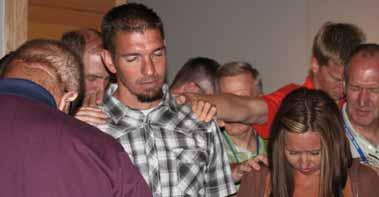




Preparing local church workers to excel in their areas of responsibility was the focus of the Southern District Conference convention held Aug. 5-7 in Norman, Okla. Guest speaker Steve Macchia, founding president of Leadership Transformations, Inc., spoke Friday evening and Saturday morning, setting the stage for 18 Saturday workshops on a variety of topics offered in three “Equipping Breakouts.”
Business was kept to a minimum, with a one-hour business session held Saturday morning. There were no oral reports from district boards; written reports were included in delegate packets. Saturday evening delegates met at the Sam Noble Oklahoma Natural History Museum for dinner and a program highlighting SDC church plants. Church planters Paul Bartel of Watershed in Kansas City and Vaughn Jost (pictured above with his wife, Taryn,) of the Micah Project in Littleton, Colo., shared stories.
During the Saturday afternoon free time, delegates could volunteer with Habitat for Humanity. The convention concluded Sunday morning.—Connie Faber

MB
receives
MB Foundation, the stewardship agency of U.S. Mennonite
Brethren, has received an estate gift of over $4.6 million, the largest ever received by MBF. The gift represents the entire estate of Gunther Henry Schmitt of San Bernadino, Calif., who died Aug. 2, 2010. Endowments established at MB Foundation to honor Schmitt’s legacy will provide significant support for nine different ministries, including education, mission and relief, for years to come.—MBF

Mennonite Brethren from across the United States will convene July 27-28, 2012 in Omaha, Neb., for Conection 2012, the biennial national convention of the U.S. Conference of MB Churches (USCMBC). Initial plans for Conection 2012 and the National Pastors’ Conference were revised in early August to give time for delegates to hear stories of God at work in USMB church plants and partner ministries, to be inspired by a series of speakers and to be introduced to the ministry of MB churches in the Omaha area.

Morning sessions of Conection 2012 will feature reports and stories of transformation from various USMB ministries. The planning team hopes to offer a variety of afternoon opportunities that highlight the ministry of USMB congregations in Omaha. The planning team continues to work out the details of special speakers and musicians for evening programs.
Conection 2012 will be preceded by the National Pastors’ Conference July 25-26. James Nicodem, author of Prayer Coach and pastor of Christ Community Church in the greater Chicago area, will speak. —USCMBC
For the first time in U.S. history, women (60%) outnumber men (40%) at colleges and universities

ABC TV’s weekly reality show Wipeout tests the endurance and self-esteem of participants in a series of comical obstacle courses, ridiculing them as they fly off into a pool of water or splat into a mud bath in front of a national audience. Eric Simpson, Pastor of Community Transformation at The Bridge Bible Church in Bakersfield, Calif., submitted to the humiliation as a contestant this summer.
Did you win the $50,000 prize?
No, but I just missed by inches getting into the top three.
Why did you go on the show?
My five kids are always harassing me to go on a reality TV show. They filled out the online application behind my back.
Why do you think Wipeout picked you?
Years of training working at Hume Lake Christian Camp in charge of high adventure stuff like the ropes course and zip line. I also have the spiritual gift of messing up.
That’s a spiritual gift?
In Hume Lake’s goofy videos my shtick was always messing up. I’m like Paul in 2 Corinthians 12:10, “For Christ’s sake I delight in weaknesses.… For when I am weak, then I am strong.”
Wipeout is a pretty rough game. Were you worried about it?
It definitely beats you up. Feels like you’ve been in a car wreck. But my biggest concern was that I would disgrace the name of God.
How did that work out for you?

2 million more women than men have graduated from college in the last 10 years 70% of valedictorians and honor roll students are women.

Source: New York Times, March 23

They definitely knew who I was and gave me the nickname “God’s gift to Wipeout.” I talked about God in my interview, but it’s Hollywood and in the broadcast version they edited out all the Christiany stuff I said.
Was it worth it?
The $50,000 would have been nice, but I was just there to make my kids proud and they loved it.
Interview by Kathy Heinrichs Wiest
The online registration system created by the Fresno Pacific University Office of Continuing Education for its distance learning program has been selected by University Business magazine as one of six winners of its Models of Efficiency Award. FPU is featured in the July/August issue of the publication (universitybusiness.com), whose audience is presidents and senior officers of colleges and universities in the United States.
FPU is the Mennonite Brethren-owned university on the West Coast.—FPU

Tabor College (TC) has surpassed the million-dollar goal for its annual fundraising campaign. At the June 30 close of the 2011 fiscal year, the Tabor Fund was$1,013,600. TC is the Mennonite Brethren-owned liberal arts college headquartered in Hillsboro, Kan. Jim Elliott, vice-president of advancement, is grateful for the many faithful and new donors.
“Without their financial gifts, Tabor College could not effectively provide a Christ-centered education for so many young people who will someday change the world.”–TC
Mennonite Central Committee (MCC) has surpassed its initial goal of raising $1 million for the East Africa drought and is expanding its response to the continuing crisis in Kenya, Ethiopia and Somalia, which has affected some 12 million people in the region. “It’s clearly the most severe food security emergency in the world today,” says MCC Africa Department director Bruce Campbell-Janz. MCC urges further support, including prayer for the people of East Africa. Learn more about the drought response at www.mcc.org/eastafricadrought.—MCC

Frank Piñon, of Reedley (Calif.) MB Church, has begun a oneyear assignment with West Coast MCC, Reedley, as the church relations coordinator. Mennonite Central Committee (MCC), a relief, peace and service agency supported by Mennonite Brethren, commissioned new workers for service after they participated in an orientation at MCC offices in Akron, Pa., July 5-15. —MCC

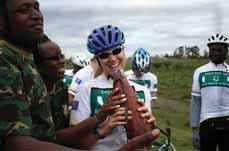
fuels
Canadian speed skater Cindy Klassen (holding gourd) tries a traditional goat milk beverage while on the Cycle for Life tour, a 300-mile, five-day bicycle tour in Kenya promoting peace clubs in that country. These peace clubs, supported by Mennonite Central Committee, use computers and social networking to encourage interaction among youth from different ethnic groups. About 30 primary and secondary schools plan to start peace clubs in 2011, bringing the total to about 180 schools. Read the full story at www.mcc.org. —MCC (MCC Photo/Michael Bade)
It has been said that retirement is when you stop making a living and start making a life. I encourage and challenge you to consider a route that will be the highlight of your retirement years. This is the path of volunteering. Based on my experiences, I guarantee you will never be the same.
When my wife and I retired 20 years ago we examined opportunities for volunteering our time in worthwhile causes where our efforts would impact our fellow man and us. During our two decades of volunteering we have learned the importance of commitment and the value of being alert to God’s nudges. In sharing our story I also want to offer suggestions to help others become volunteers.
Be committed
Make the commitment to serve. Don’t spend too much energy fretting about what to do. Wait to see the exciting opportunities God puts in front of you as you move out in faith. But it takes that first step of commitment to get moving.
Currently my wife and I are between volunteer assignments. We do not know at this point what is next. We feel drawn in several different directions, but I don’t believe God will prod us one way over the others until we make the commitment to be involved.
Once you’ve committed yourself to serving, decide what skills you want to use. Do you want to build on what you already know or develop new skills? Even though previous work experience lends a clue for deciding what to do, most organizations that use volunteers will train as necessary.
Consider your other priorities. What other considerations need to be included in your volunteer plan?
My wife and I were both government workers in our “other life.” I had limited building skills, but I did enjoy being a fix-it type of person. We both agreed that we wanted to travel and live in our fifth-wheel trailer.
Now look for organizations that fit your goals. You may choose to volunteer with a secular or Christian organization. With the proper attitude either can become an avenue of expressing one’s belief. Serving with a faith-based organization can be a double blessing because you are expressing your walk of faith and helping the Christian organization. One Web site to visit on the Internet is Senior Opportunities for Older People (SOOP), a Mennonite Mission Network component.
My wife and I follow five steps in selecting an organization to volunteer with. We collect information about the ministry, identify needs and define our opportunities to serve. We complete the application process and explore the details of the assignment. When all five fall into place, we believe God is affirming the plan.

by DON BULLER
Mobile Missionary Assistance Program (MMAP) is the first organization we worked with. Volunteers with MMAP serve three weeks at a time, working six hour days, four days a week in construction-related work building churches, Christian campgrounds, homes for handicapped, etc. We were assured that we would work with experienced people. That was enough for us.
While volunteering with MMAP we worked in more than 70 locations throughout the United States in 12 years. Later we joined Servants On Wheels, Ever Ready (SOWERS), a similar organization that offered comparable work. Working with these two organizations we were able to pursue our love of traveling and to go places we had never heard about. We spent our days off exploring the area where we were working. We met new people and developed lifelong friends by working together in a common endeavor.
In our volunteer faith journey we discovered that Habitat for Humanity has an RV component so we did some work with them. Then we felt God nudge us to work for Mennonite Disaster Service (MDS) and we modified our volunteer activity plan again. Our administrative skills came in handy when MDS asked us to direct work projects in various locations. We were truly the hands and feet of Jesus in helping needy persons.
We often talk about God leading us. I find that God leads me through awareness, nudges and concerns. Responding to these prods has opened avenues of service.
Soon after Hurricanes Katrina and Rita hit the southern states we were wintering in Arizona. Even though we were enjoying time off from volunteering I could not get the many people affected by this disaster out of my mind. Looking back I can see that this concern was the nudge of God to get involved again. Discussing this with my wife I learned she felt the same way.
Leadership is always needed at a disaster location. That winter it occurred to me that with my experience I could volunteer as a crew leader or construction foreman. I had passed the three-quarter century mark and a 40 to 45 hour workweek would have been a little too strenuous. But crew leading would be different. When I talked to MDS they asked me to be the project director and my wife to be the office manager in Point Aux Chenes, La. We accepted the challenge and God was with us through many “opportunities”—some would call them problems. While in Point Aux Chenes, God led us with another nudge. Many retired folk have recreational vehicles and would work on an MDS project but by choice or age limitations cannot work the 40 to 45 hours weekly in an
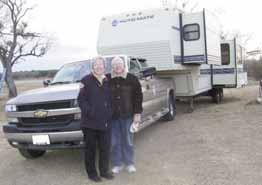
MDS camp setting. So we suggested that MDS develop a RV component and MDS asked us to set up and direct the first MDS RV camp. We recommended a four-day workweek, six hours daily and four-week minimum commitment and wrote the RV manual for leaders.
We started the first MDS RV project near Mobile, Ala., and later directed one in Hackberry, La. God blessed and the two pilot projects led to a full program with MDS. We recommend this program to anyone with a self-contained recreational vehicle.
We continued to respond to God’s leading, enjoying time between each assignment to reflect on the blessings of God and to wait for the next nudge. The summer of 2007 we served as tour guides at MennoHof Interpretative Center in Shipshewana, Ind. We lived in a furnished apartment and in three months saw 10,000 folks from all over the world come through the center.
Our next nudge took us to Southern California to build a house destroyed in the wildfires. Then we volunteered near our Fresno, Calif., home for a Mennonite medical facility in Atwater, Calif., that was rebuilding their facility.
Volumes have been written on planning for retirement and choosing how to spend one’s time during this phase of life. I believe that our retirement years can become the best years of our lives when these years involve God’s service. Life takes on a new interest when we invest in the lives of others.
Don Buller and his wife, Marilyn, pictured above, attend Bethany MB Church in Fresno, Calif. They were elected the RV'ers of the Year for 2010 by the Good Sam RV Club, a national organization, for their work in starting the RV program for MDS. They also serve on the California MDS Board. When at home they enjoy their three children, 12 grandchildren and two great-granddaughters.

by LYNN JOST









What Mennonite Brethren pastors say about their preaching and what they actually preach
Irecently asked a group of Mennonite Brethren pastors whether they describe themselves as biblical preachers. Except for one who demurred because he prefers the moniker “teacher” to “preacher,” every one of the dozen or so respondents said they are or at least want to be a biblical preacher.
When asked to define “biblical preaching,” several pastors stated what we might think to be obvious—biblical preaching starts with choosing a biblical text. Some emphasized that biblical preaching must yield transformed lives. A leading preacher (and teacher of preaching) said that biblical preaching expounds, proclaims and applies a biblical text. He added that it is preaching aligned with the overall biblical message.
Another responded that the biblical preacher “seeks to sit under the authority and direction of the Scriptures, articulating as best she/he can what the text meant to the original reader/listener and then seeking to take that meaning and build a bridge to the local context in a way that accurately reflects what the original scriptures meant and how they are to inform, transform and direct our present
life.” He added, “A message should be consistent not only with the text itself but the overall canon of Scripture.”
That’s what preachers say about preaching. How do we actually preach? To start answering that question, I asked MB Biblical Seminary alumnus Matthew Insley and MBBS student Amy Stone to review the bulletin archives of six U.S. MB churches to see what we could learn about preaching from their bulletins. Three churches were from the Pacific District Conference, two from the Southern District Conference and one from the Central District Conference. The results were presented at the Renewing Identity and Mission consultation at the Celebrate 2010 convention in July 2010. Here’s a snapshot of what we learned.
Bulletins report that the senior pastor is preaching less than he used to, down from 80 percent in the 1950s to 63 percent in the 2000s. Visiting preachers have consistently preached about one-fifth of the Sundays. Staff pastors preached more than 10 percent of the sermons in the 1980s
and 1990s, but that number has declined to 6 percent in the 2000s. Preaching by women comprises less than .5 percent of all preaching in the churches surveyed, with a very slight increase from the 1970s to the present.
What are our favorite biblical texts?
Bulletins do not always report which text is to be preached. The text is reported in the bulletin 73 to 84 percent of the time in the Midwest churches studied and 40 to 55 percent of the time in the California churches studied. The epistles were the most popular biblical texts, with the Gospels running a close second. Seventy-three percent of the sermons come from the New Testament, 36 percent from the epistles, 30 percent from the Gospels and 5 percent from the book of Acts.
Old Testament historical books account for 13 percent of recorded sermon texts, Old Testament prophets nearly 7 percent, Psalms 4 percent, apocalyptic texts nearly 3 percent and Pentateuch and wisdom literature about 1 percent each. The dominance of the epistles (which comprise only about 8 percent of the pages in the Bible) was most pronounced in the decades of the 1970s and the 1990s when they comprised over 40 percent of all recorded sermon texts. In the decade of the 2000s the gospels exceed the epistles, about 40 percent and 30 percent respectively. When the Acts of the Apostles are included with the Gospels, they accounted for more than 45 percent of all sermon texts in the 2000s.
The researchers analyzed use of the liturgical calendar. Bulletins unfailingly reference Christmas and Palm Sunday and Easter—and Thanksgiving. There is a shift over time to increased attention to the church year: first Advent and later and less universally, Lent. Increasingly, Pentecost is noted as the day’s theme. The “Hallmark” holidays receive attention, notably Thanksgiving, Mother’s Day, Father’s Day and Valentine’s Day. The Fourth of July and Memorial Day are celebrated in at least one congregation.
Conclusions
What does this mean? How can we learn from these findings?
1. We need to preach the whole counsel of God. Biblical preaching should include every part of the Bible, particularly the Gospels and the Old Testament. The recent trend to emphasize the Gospels is healthy.
Preaching primarily from any single genre tends to distort our understanding of God’s design. Neglecting the Old Testament truncates our understanding of God’s design as well as the saving work of Jesus. One way to increase use of the whole canon is to read the Bible as a story in six acts
(creation/fall, God’s work in redeeming a people, exile, Jesus, the church, which is the part of the story in which we live, and consummation). As is true of stories generally, this story needs every one of the acts to give the full story. I would encourage preaching from each of these acts more than once each year.
The International Community of Mennonite Brethren Confession of Faith may also provide a model for text selection. This confession is composed of a narrative and of a series of five statements about the church—people of the Bible, of a new way of life, of reconciliation, of covenant community and of hope. Using these categories could help us to balance the preaching.
We can also benefit from an explicitly biblical theology like the one articulated by Elmer Martens in God’s Design (deliverance, covenant community, knowledge of God and abundant life). Biblical theology includes the teaching of Jesus, particularly the Sermon on the Mount, the Great Commission and the Greatest Commandments.
2. Sharing the pulpit is positive. Balancing the preaching of the pastor, other local preachers and guest preachers is good for congregants and for pastors. The growing number of voices reinforces the biblical concept of the priesthood of all believers. The move portends an act of self-care that will protect the mental and spiritual health of the pastor. An important discipling ministry of the local pastor could include gathering a group of prospective preachers for guidance in preparing, delivering and evaluating sermons.
3. I grieve the paucity of preaching by women and believe it needs to change. Scripture seems quite clear in indicating that, when women have adequate preparation, they speak prophetic words and teach.
4. Giving attention to the church year, particularly Lent and Advent, is encouraged. Recognition of pagan and national holidays seems to open the way to idolatrous syncretism.
5. Biblical preaching includes but goes beyond starting with a biblical text. Biblical preaching brings the preacher under the authority of the Bible. Biblical preaching, while proclaiming a single text, must be consistent with a thoroughly biblical theology. Biblical preaching creates a new imagination of the community that God is creating through Jesus.
Lynn Jost is dean of Fresno Pacific Biblical Seminary and vice president at Fresno Pacific University, Fresno, Calif. This article is adapted from Jost’s presentation at the Renewing Identity and Mission Conference (RIM) held last summer. All papers presented at RIM are being published by Kindred Productions in the book Renewing Identity and Mission: Mennonite Brethren Reflections After 150 Years, to be released this month.
christian


If you like stories, this article is for you. But don’t let the title fool you. These are not tall tales. They are true.
The source of the first one is Scripture. The second one dates back to the beginning of the Mennonite Brethren movement. And the third one, well, you will know that person. What weaves this cast of characters together? They are all rich.


The first rich person is most commonly known as “the rich young ruler.”
In Mark 10:17-31 he is described as merely “a man.” Though you may know the story, read it afresh today.
As Jesus started on his way, a man ran up to him and fell on his knees before him. “Good teacher,” he asked, “what must I do to inherit eternal life?”
“Why do you call me good?” Jesus answered. “No one is good—except God alone. You know the commandments: ‘Do not murder, do not commit adultery, do not steal, do not give false testimony, do not defraud, honor your father and mother.’”

“Teacher,” he declared, “all these I have kept since I was a boy.”
Jesus looked at him and loved him. “One thing you lack,” he said. “Go, sell everything you have and give to the poor, and you will have treasure in heaven. Then come, follow me.”
At this the man’s face fell. He went away sad, because he had great wealth.
Jesus looked around and said to his disciples, “How hard it is for the rich to enter the kingdom of God!”

The disciples were amazed at his words. But Jesus said again, “Children, how hard it is to enter the kingdom of God! It is easier for a camel to go through the eye of a needle than for a rich man to enter the kingdom of God.”
The disciples were even more amazed, and said to each other, “Who then can be saved?”
Jesus looked at them and said, “With man this is impossible, but not with God; all things are possible with God.”
Peter said to him, “We have left everything to follow you!”
“I tell you the truth,” Jesus replied, “no one who has left home or brothers or sisters or mother or father or children or fields for me and the gospel will fail to receive a hundred times as much in this present age (homes, brothers, sisters, mothers, children and fields—and with them, persecutions) and in the age to come, eternal life. But many who are first will be last, and the last first.”
Why recount this story? I think it is one of the most misunderstood passages in Scripture. For about 18 centuries, scholars almost unanimously have taught that the rich man missed the kingdom on account of his riches. Interestingly, the text does not say that.
Just prior to this time, around the year A.D. 200. Clement of Alexandria looked at this text in his treatise: “Who is the Rich Man Who Will be Saved?” He urged: “Do not judge who is worthy and unworthy” because you may be mistaken and called readers to “accommodate rather than criticize” the rich man.
If Jesus looked at him and loved him, we should not be so quick to condemn the guy.
Consider next the response of the rich man after Jesus invites him to go, sell, give, come and follow. I think you may see what Clement saw and what I recently discovered. It reads: “At this the man’s face fell. He went away sad, because he had great wealth.”
Commentators, I believe, have mistaken his sadness as rejection.

by GARY G. HOAG

This Greek word for “sad” is found two other times in the book of Mark. Sad first appears in Mark 6:26 when Herodias danced before Herod. In appreciation he offers her any wish up to half his kingdom. Her wish was the head of John the Baptist. What was Herod’s response in 6:26? He was sad. Same root word. Did he do what he said he would do? Unfortunately, yes.

The other occurrence of this word is found in Mark 14:32-34 when in Gethsemane Jesus asks his disciples to wait while he prays. Jesus was “overwhelmed with sorrow.” He was really sad. Same root word. But even with the hard road ahead of him, did he go to the cross for us? Thankfully, yes!
Now let’s return to Mark 10:21-23. The text says the rich young ruler’s response to Jesus invitation to go, sell, give, come and follow was that “he went away sad, because he had great wealth.” I think he left sad not because he rejected the gospel, but because he knew he had work to do. Hard work. This notion is affirmed by Jesus’ response: “How hard it will be…”
Menno’s story is inspirational because he found true wealth in a time when people were spiritually bankrupt. And, rather than hoard his heavenly riches he shared them freely regardless of the personal or financial cost.
In his book, 17 Injunctions, Menno writes, “True evangelical faith cannot lie dormant. It clothes the naked, it feeds the hungry, it comforts the sorrowful, it shelters the destitute, it serves those that harm it, it binds up that which is wounded, it has become all things to all people.”
Despite intense religious persecution, Menno dedicated his life to following the teachings of Jesus as recorded in Scripture and encouraged others to do the same. Many joined him and became known as the Mennonites.

Jesus does not condemn the rich man. He’s sympathetic. He knows how hard it is for those who have riches to lay them aside because he laid aside the riches of heaven to come to earth to give his life for us.


Menno Simons was born in the Netherlands in humble circumstances in 1496. In 1524, he became a Catholic priest and served in that capacity for 12 years. Ironically, in that era priests knew a lot about church traditions but almost nothing about the Bible. So what made him rich? When wrestling with spiritual questions during the Reformation, Menno studied the Scriptures. This made him rich, spiritually rich.

You and I represent the third rich person. We are rich. Statistics show that if you make $25,000 a year, your salary ranks in the 90th percentile of the richest people in the world. If you make $50,000 a year you are in the 99th percentile. See how your salary ranks compared to the rest of the world at www.globalrichlist.com. From a global perspective, you and I are financially rich.
We are spiritually rich too. We have what rich person #1 was seeking. We’ve got Jesus. And, we are not alone in following him. Thanks to rich person #2 we are a part of a spiritually rich Mennonite Brethren community of faith.
Blessed with both material and spiritual wealth, what should we do from here? Let’s revisit verse 21 one more time, and I think we’ll find a three-part answer: “Jesus looked at him and loved him. ‘One thing you lack,’ he said. ‘Go, sell everything you have and give to the poor, and you will have treasure in heaven. Then come, follow me.’”


First, we need to remember Jesus sees us and loves us. This amazing truth is intended to provide us with the peace we long for but often miss because we make the mistake of seeking security in earthly treasures.
Second, I believe we need to get to work. To heed the command to “Go, sell everything and give to the poor,” is to let go of that stuff which can’t save us, give us security or satisfy us, and instead share it, like Menno, with broken and hurting people around us.
Third, to “come and follow” is simply an invitation from Jesus to practice Christian generosity. What’s this look like? I am not asking you to make a year-end gift to your church. I am asking you to join my family and me in being the gift.
Where can we start? My family has decided to stop storing up treasures on earth, and instead pour them into the needy around us in the name of Jesus. We ask God daily to fill our cups so we have enough to give to him, to meet our needs and to share with others following the Spirit’s leading.
It’s hard. It’s costing us everything, and we are not done because there are still so many things we hold on to. In this journey, we are thankful that Jesus is loving and gracious toward us.
Menno got it, and I tend to think the rich young man did too, because as some scholars have posited, I think the rich young man may have actually been Mark himself, the writer of the Gospel. How else would he have been able to testify about the love extended to him?
I can’t finish this tale of three rich people without you. My prayer is that you will join my family and me on the journey of practicing Christian generosity; in so doing, you will experience and share the love of Jesus like never before.
Gary Hoag attends Trailhead Church, a Mennonite Brethren church plant in Centennial, Colo, with his wife, Jenni, and two children, Sammy and Sophie. Hoag is completing his PhD in New Testament at Trinity College in Bristol, England. Hoag recently co-authored The Sower: Redefining the Ministry of Raising Kingdom Resources; contributed a chapter to Revolution in Generosity; and served as a content reviewer for the NIV Stewardship Study Bible. To read his daily meditations on Christian generosity visit: www.generositymonk.com.

To heed the command to “Go, sell everything and give to the poor,” is to let go of that stuff which can’t save us, give us security or satisfy us, and instead share it, like Menno, with broken and hurting people around us.

Visual art is much more than pretty pictures to Oklahoma artist Dan Gibson, founder of Art Community for Christ. “My focus is trying to show our walk with Christ, our experience with him, our struggles and the things that are joyful,” says Gibson. “It’s about our daily walk with Christ.”
Gibson formed Art Community in May 2010 to encourage Christian artists to use their talents to bring honor to God. The community is part of Discovery Bible Fellowship (DBF), a Mennonite Brethren congregation in Collinsville, Okla.
Gibson says he has always been “into art” and pursued art as a side interest, often joining groups of artists for mutual learning and inspiration. But the groups didn’t have any kind of Christian focus, and after a while, he felt that lack keenly. He grew dissatisfied with creating for himself and began to ask what would bring more satisfaction. The answer: “I should use all my gifts and all my talents to glorify God.”
He approached DBF pastor Derk Madden with the idea of forming a community of Christian artists who would not only encourage one another artistically but also look for ways to serve and spread the gospel through their art.
The church leadership enthusiastically embraced the idea. They set aside an area of the church facility for the art group and helped spread the vision. Response from the DBF congregation has also been positive, as evidenced by affirming comments and valuable project suggestions.
Gibson says he didn’t know any Christian artists when he began to advertise the group and wasn’t sure who would come. But they did come.
About seven artists now meet each Tuesday evening, spread drop cloths and pull their projects out of storage to paint, draw and create. They always work on an assigned project—something they’ve agreed together to do. The advantage of working on the same project, says Gibson, is unity. “We’re all feeling the same vision.”
Artists are often independent souls used to working alone, Gibson points out, and so it is significant that they work together toward a goal. “It brings us together and we learn from each other,” he says.
Because he started the group without knowing who would come, Gibson says he didn’t know what level of skill to expect from the artists, but he has been pleasantly surprised. “Every artist is extraordinary,” he says, humbly adding that he

considers himself one of the weaker artists in the group. In addition, he says, every artist has a heart for the group and a passion for spreading the gospel.
The artists each have a favorite style and medium—watercolor for one, pastels for another— but projects tackle a variety of both media and styles. “We all dabble a bit in everything,” Gibson says. In that way, the artists learn from and challenge each other: “Each person has a strength. That’s really great because we can teach each other.”
As they use their gifts, refine their talent and strive for excellence, the artists draw closer to God. Gibson talks about art that “expresses our love for Christ” and about “creating something God would delight in.”
While they work, the artists build relationships that also serve to draw them closer to God. “It’s never quiet in there,” Gibson remarks. They talk not only about the project at hand but also about their daily lives and their faith. They don’t open Bibles for formal study but encourage and challenge each other nonetheless. “We’re starting to lean on each other through difficult times,” Gibson says and calls the group a “family of artists.”
For this Art Community, the art is “for Christ.” Gibson says, “We don’t just keep it for ourselves,” but always ask how it might serve a greater purpose. Each project aims to serve or spread the gospel in some way. The artwork might be donated to further some ministry or sold to raise funds for a charity.
“Kwero” is a perfect example. This past spring, the artists invested four months in drawing and painting portraits of specific Ugandan orphans who are being given health care and education at an
orphanage founded by Project Hope Worldwide, an outreach of Discovery Bible Fellowship. About 16 of these portraits were sold at an April 15 fundraiser, called Kwero, raising $7,000 for the care of these children. Gibson says giving orphans a second chance in this way “displays someone who wants to be more like Christ.”
At first, the Kwero project guidelines dictated a fairly uniform style, but as the artists began to work, the group decided to allow more latitude for expression. As a result, each portrait is unique and uniquely inspired, but the project as a whole has a common theme.
The artists enjoyed the project so much that, instead of doing just one portrait each, they found themselves working on several and giving extra time. And, as they worked, they connected with the orphans in a way that only an artist and subject can. “After a while, you become really invested in these children,” Gibson says. “I got to spend time learning about them and painting them.”
Gibson, artist Ceasar Condes and Project Hope Worldwide representative Kelley Compton had an opportunity to talk about the Kwero portraits and gather support for the orphans on local television.
Next spring, the group hopes to have a booth at the Blue Dome Art Festival in Tulsa, Okla. Gibson says that, while art always expresses the heart of the artist, including the artist’s love for Christ, the meaning isn’t always obvious, especially with more modern styles. So as festival visitors
browse, view the art and ask questions, the art can become a springboard to share the gospel. “That’s a way for us to talk about Christ and talk about our testimony,” Gibson says.
“The whole mission is to spread the gospel. If we can do that in the modern art style or by painting orphans, those are ways to reach people,” says Gibson.
For more on the Art Community for Christ and to see some of the Kwero portraits, like them on Facebook. — Myra Holmes
“We have some amazing talent in the group,” says artist and Art Community founder Dan Gibson.

Manage programs and projects with multiple partners in food security, peacebuilding, education and health
erse teams div
tion and health educa security ams pr ogrpr ocal an ood ojects
Lead diverse teams of local staff and international workers
eporting ersee r Ov tional interna
Oversee reporting to diverse set of stakeholders
orking y w Enjo
Enjoy working in a vibrant and unpredictable setting
tingset






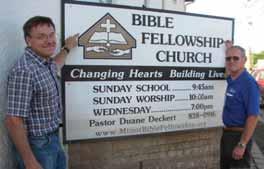
As members of Bible Fellowship Church, a small Mennonite Brethren congregation in Minot, ND, talk about the helplessness of watching the waters sweep away hopes and about a faith that stands firm, snatches of a classic hymn come to mind: “On Christ the solid rock I stand, all other ground is sinking sand.”
For them, the hymn’s “whelming flood” is literal: The Souris River flooded Minot June 23 in the worst flooding there since 1881. At least 11,000 of the town’s 40,000 residents were evacuated, including seven families from Bible Fellowship, a congregation of only about 60. About 4,000 homes were flooded, including the parsonage. The Bible Fellowship church building, too, was flooded with about 10 feet of water.
But the facts don’t tell what it feels like to come home after the waters recede, to see the mold consuming a lifetime of belongings and memories. “Devastating,” says Val Keeney of Bible Fellowship. Floodwaters rose over four inches onto the main level of
the home she and her husband spent 20 years pouring time and money into—the home they believed God had called them to use for hospitality and ministry.
Words on paper can’t carry the smells that linger—mold and decay mingled with methane and chemicals. The statistics don’t include the piles of soggy belongings on the curb that crop up as quickly as they’re cleaned away— piles that represent lives, memories and hopes.
Even those whose homes were on higher ground talk of an overwhelming sense of loss. One of those spared, Cory Nissley, says that when folks ask if the flood affected him, he tells them that when a big flood hits small community everyone is affected. “It’s hard to explain how bad the flood was and how it affected the whole town until you’ve been here and seen it,” he says.
Violet Vix, another Bible Fellowship member whose home was safe, describes the cloud of uncertainty that hung over the congregation as they met after the flood. And yet, she says, “We needed to be together.”
The facts also can’t tell how faith becomes a hope and stay when all else around gives way. “It takes you to that place to see if what you said is true,” Keeney says. “Do you really trust that God is who he says he is?”
Keeney has been drawn to the Old Testament story of Job, who believed in God before his trials but knew God deeply after. She hopes that her faith, too, will prove more firm after the flood. “At the end of this, I’m going to be a better follower of Christ than when I entered into it,” says Keeney.
Minot residents have a long way to go. The initial shock was quickly absorbed in the scramble to gut damaged buildings—including the church and parsonage—and inhibit the growth

of mold. Mennonite Disaster Service (MDS), the disaster response agency supported by Mennonite Brethren, was among the agencies that responded. Volunteers poured in.
Again, a report of the numbers of volunteers wouldn’t begin to tell what that hands-on support has meant to Minot residents. Emotion rises to the surface as Duane Deckert, pastor of Bible Fellowship, talks about those volunteers. “It’s just incredible that people would come, give a couple of days to clean the muck out of people’s homes just because they love Jesus,” he says. “That’s when we really see God at work.”
Nissley, who took a turn at organizing the MDS volunteers, says those who have rolled up their sleeves have been an important witness in the community.
With the initial chaos of cleanup over and the harsh North Dakota winter just around the bend, Minot enters a new season of uncertainty. Rumors swirl of another flood coming in spring. Since few in Minot had flood insurance, too many are left without resources to rebuild, even if they want to risk it. And Keeney says that even if they had the money to rebuild, “I don’t think we have the stamina.”
Deckert says the church can offer hope when hopelessness begins to settle in. “That’s where MDS and the church come in: We can be the hands and feet of Jesus to people,” he says.
In order to better show the love of Christ to Minot, Bible Fellowship and MDS have entered a two-year partnership. Together they are rebuilding Bible Fellowship Church to the “bare bones,” a just-functional facility that will include a place for the congregation to worship
as well as housing, showers and restrooms for up to 30 MDS volunteers at a time. Barring unforeseen obstacles, they hope to be using the building for worship and volunteer housing by November.
MDS’s two-year commitment is huge, says Deckert. While many relief agencies are pulling out, Deckert describes a valley still desolate, still devastated and still in dire need.
The two-year partnership with MDS will also give Bible Fellowship much-needed time to discern next steps. Rebuilding on their current site or relocating, perhaps to a growing part of town with new opportunities for outreach, are among the options.
As Bible Fellowship looks to the future, the continued support of the larger Mennonite Brethren family will help them stand firm. Deckert asks for prayer for “a hearing heart,” for unity and for obedience. “Prayer keeps us strong,” he says.
Because Bible Fellowship, like so many, didn’t have flood insurance and because they don’t qualify for assistance from the Federal Emergency Management Agency (FEMA), financial support is also important. Donations to assist the Minot MB congregation are being channeled through MB Foundation (MBF), the U.S. Conference stewardship ministry, and can be sent to MB Foundation at P.O. Box 220, Hillsboro, KS 67063. Checks should be made payable to “MB Foundation” and reference “Minot Bible Fellowship Church Rebuilding Fund.”
Most importantly, Deckert says, come to Minot. Because the facts in black and white can never adequately portray the devastation of the flood, nor can words adequately show how solid is the rock on which they stand. To volunteer, contact the MDS office at 800-241-8111.
Myra Holmes
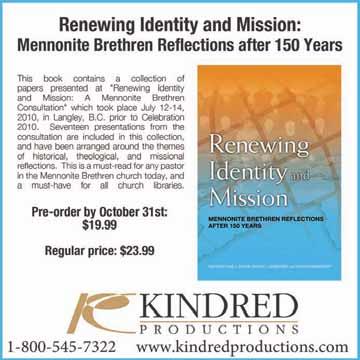
“These kids shouldn’t be going hungry”
When Steve Klassen teased the boy from the Gateway apartment complex about wolfing down seconds on lunch, the boy matter-of-factly told Klassen that he hadn’t eaten yet that day. He and his siblings, the boy said, had to choose either breakfast or lunch each day. Not both.
That’s why Klassen and others from Memorial Road MB Church (MRMBC), Edmond, Okla., spent their summer delivering lunch to kids in this apartment complex.
“These kids shouldn’t be going hungry,” Klassen says.
The Gateway apartments are only about three miles from the church geographically but might as well be a world away. While MRMBC is largely composed of white, upper-middle class folk, Gateway residents are mostly African-American and trapped in a cycle of poverty.
Although residents receive housing assistance, food stamps and help with utilities, Gateway community manager Ronda Derendinger explains that this assistance often doesn’t stretch far enough for simple things like clothing, shoes or school supplies for children. Each of the more than 200 apartments houses at least one child; some house up to seven. That’s a lot of kids. And they are too often literally hungry.
MRMBC’s involvement in a summer lunch program for Gateway fell into place so quickly that it’s clearly not the result of human planning. The idea first came from Donna Orrell of MRMBC’s outreach team who heard about another church serving lunches at a needy apartment complex in another city. Couldn’t MRMBC do something similar?
She and Kerstin Klassen, Steve’s wife, began researching the idea. They knew that the school district provided summer lunches to kids who qualify for the free and reduced school lunch program, but they quickly learned that a huge pocket of kids who qualify—like those from Gateway—have no way to get to the distribution site. So Orrell and her hus-
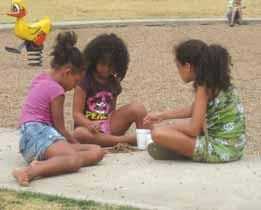
band, Doyle, offered to pick up the lunches provided by the school district and deliver them to Gateway. It seemed a perfect plan.
But the school program, and therefore the MRMBC volunteers, had to comply with a plethora of government requirements. The day the rules required them to refuse a lunch to a boy with no legs, the MRMBC volunteers decided to take on the lunch program as a church project, not a partnership with the schools. From early June until the start of school Aug. 18, the church prepared, delivered and served about 80 lunches every weekday to children up to age 18 at Gateway—a total of 4,280 lunches over the summer.
The Orrells oversaw weekday distribution of the lunches. “I looked forward to going out there every day,” Donna says. This retired teacher clearly loved meeting and building relationships with those at Gateway: the grandmother who felt trapped as she raised five grandchildren, the teen mom who never smiled, the woman who was beginning to express interest in Bible study. While a part of her would be content to enjoy retirement quilting on her front porch, Donna says she belonged at Gateway this summer.
Soon after the weekday lunch program was rolling, volunteers began wishing for more time to interact with the kids and meet their families. So they expanded the outreach to include lunch and activities on Sundays. Wal-Mart provided discounted prices on fried chicken, and volunteers prepared appropriate side dishes ahead of time so that the meal was ready to go after Sunday services. In addition, volunteers offered a variety of activities; one of the most popular was reading Bible stories aloud. It was an opportunity for folks from MRMBC to get to know children and families from Gateway in an informal way.
“That really is the crux of what we want to do,” says Donna. “We want to feed children, but we want to establish relationships as well.”
Derendinger affirms the importance of the relationships built. She saw excitement and giggles as the children anticipated these visitors who would listen to them and call them by name. In home and school situations in which they are often overlooked, even these small gestures helped give the children the personal attention they crave. And exposure to a different way of thinking about things like education and work, she says, showed the children
possibilities beyond life on public assistance. “It wasn’t just about the food,” Derendinger emphasizes.
The six-day-per-week effort took a sizeable volunteer force, organized by Kerstin Klassen.
Significantly, some 30 children from MRMBC participated in one way or another, including the Klassens’ four young children. Kerstin says it gave their children an opportunity to put into practice lessons learned in Sunday school. The church’s small junior high Sunday school class also took the project to heart, giving their time, donating toys and even raising funds by selling lemonade. For children as well as the adult volunteers, Steve says, serving at Gateway was an exercise in putting faith into practice.
Funding came from a variety of sources: church members, corporate sponsorships and donations, even other local churches.
An article in the local newspaper early in the project brought community-wide interest and additional donations so that MRMBC never had to solicit funds to cover the costs. “It’s been like the feeding of the 5,000,” says Kerstin.
It helped that those who planned the menus and shopped for the groceries, including Kerstin and Cheryl Devoe, worked hard to keep costs down to just over $1 per kid per day. For that dollar, weekday lunch menus were basic but balanced and nutritional: sandwiches, spaghetti, burritos or hot dogs.
Aside from the record-setting heat, the biggest challenge of the summer was dealing with the trash generated. After an early experience in which Styrofoam dishes clogged a pool pump, the church rallied volunteers to clean up trash, and Gateway increased efforts to teach children the value of cleaning up after themselves.
For both MRMBC and Gateway, the benefits of the summer experience far outweighed the challenges. Both hope the partnership has only begun. The possibilities are many: tutoring, GED help, parenting classes, Bible studies, automotive repairs and playground maintenance. “There is more here for us to do than feed kids in the summer,” Donna says. “We’re waiting to see what opens up.” —Myra Holmes




Welcome to the new Everence – the result of MMA and Mennonite Financial Federal Credit Union growing together to offer you complete financial services rooted in faith and values.
Talk to your local representative or visit www.everence.com to learn about the new benefits of becoming a member. A ministry of Mennonite Church USA and other churches elcome Ever W
Let’s ’s esult ence r ow s gr of and Mennonite Financial Federal Cr Chur n member to lear alk yo T Ta fer r edit gr ches ch USA and other chur esentative or visit www eprr ooted owing .everence.com















Don Morris Mission USA director
It is so easy for me to grumble. I find myself grumbling about a lot of things that are totally out of my control. As I write this Oklahoma is enduring the hottest summer on record. Daytime temperatures have often hit 110 degrees. Along with the heat, one can almost hear the collective wail of every person in Oklahoma: “It is sooooo hot!” “Can you believe how hot it is?” “We’re burning to a crisp!” “ Even the swimming pool has hot water in it now!” Grumbling.
Another thing I find myself grumbling about is our government’s handling of the nation’s finances. No, it’s not a pretty picture, and it’s easy to be frustrated. More grumbling. “How can they do this to us?”
I grumble when I have to get up early. I grumble when I have to mow the lawn—again. I grumble when the electric bill comes. I grumble when my wife doesn’t see things my way. I think I have a pretty good case for my grumbling, don’t you?
The Apostle Paul breaks into my reasonable grumbling with some words of wisdom. He writes, “Do everything without grumbling (emphasis added) or arguing, so that you may become blameless and pure, ‘children of God without fault in a warped and crooked generation.’ Then you will shine among them like stars in the sky as you hold firmly to the word of life” (Phil. 2:14-16).
Great. Out the window flies my righteous grumbling. And there are other passages referring to grumbling. God simply doesn’t like it. Instead, God wants us to focus on what’s truly important as we follow him. And when we do that, it’s not as easy to fall into grumbling.
Even when it’s 110 degrees outside, God wants us to focus on being salt and light. Even when things aren’t going quite right in some area of my life, God wants me to pray for people who don’t yet know him or who are going through a tough situation. Even when I think I have a suitable case for being in a grumbling mood, God is looking to me for fellowship with him. Even when things look bleak, God wants me to see all the good things he’s providing and to focus on those.
For me, it’s also easy to grumble when I compare my ministry with the one across town that has thousands of people attending and that attracted 2,800 people the first Sunday their new campus was opened. “Why can’t we have that happen for us too, God?” Grumbling. God doesn’t like it.
What does God seek instead? For us to love him and to serve him with the right attitude— without grumbling. Paul reminds us of this with these words from Romans: “Never be lacking in zeal, but keep your spiritual fervor, serving the Lord.” Zeal. Fervor. Serving the Lord. No grumbling allowed. “But Lord, have you stepped outside today? It’s boiling out there and.…”

THE ETHNIC GROUP that reflects the most profound level of religious change over the last 20 years in America is Hispanics.
Source: Barna Group, 2011

Did YOU know?



The percentage of UNCHURCHED HISPANIC ADULTS jumped from 20% in 1991 to 40% today.


Church planting today is more successful than it was even 15 years ago. Recent research by organizations such as Lifeway Research, led by author and speaker Ed Stetzer, indicates that church plants across America have roughly a 15 percent higher success rate than in 1995.
“We are doing many things better and much of this is due to the emergence and development of church planting systems,” writes Stetzer.
Success of Mennonite Brethren church planting is following this national pattern. The MB church plant success rate for the past 15 years is around 80 percent, which is where the national average stands. A “successful” church plant means the new church reaches a point of selfsufficiency and viability.
One of the most important ingredients for successful church planting is church planter assessment. Mission USA, along with the various district church planting boards, is committed to having each potential church planter assessed by a competent independent assessment agency. Typically a potential church plant couple will spend three to four days in an intensive assessment that includes personality profiling, psychological reviews, giftmix analysis, family health review, physical health review and peer assessment. There are also in-depth ministry-related exercises and performance reviews. It is a challenging event.
“It continues to amaze me how much we learn about a couple’s readiness for church planting through these intense assessments,” says Mission USA director Don Morris. “Sometimes couples attempt to fool the assessors when they first arrive at an assessment, trying to put on a flawless front. But the assessments are so involved that we soon see the couple’s realities. Assessment is not perfect, but it’s a great filter. We don’t want to put couples into the tough realm of church planting until they’re truly ready.”
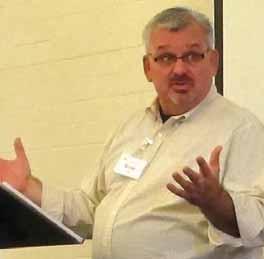
Mission USA has used various assessment agencies, but most often uses Church Planting Assessment Center based in Johnson City, Tenn. Up to 10 assessors, including an assessor from Mission USA when a Mennonite Brethren couple is being evaluated, and 12 to 14 couples are involved in the process.
True church planting success involves not only the sustainability of a new church. More importantly is whether that new church is seeing life-transformation. According to Morris, that’s how all of this fits together.
“If we assess people for church planting and simply determine that they have good skills, that’s one thing. But if we discern that they have a passion for reaching those who don’t know Jesus, that’s something even more vital,” says Morris. “So, we look for both—skills for planting and a burden for the lost. Why else would we invest so much time, energy and funding into church planting if it wasn’t to help build God’s kingdom?”
One thing is certain: Church planting is getting better returns these days. No longer is it just a shot in the dark. Good systems, networks, planning, partnerships and funding initiatives have all added up to help ensure that when a church is started it has a high degree of expected sustainability.
But without assessment, even those safeguards are incomplete. Morris says, “Even if Billy Graham came to us and wanted to plant a church, the first thing we would do is send him to assessment.”

Ateenager is at a particularly vulnerable stage of life to go through the divorce of parents. Perhaps you have witnessed a teenager going through the divorce process and have wondered, “What can I do?” First, recognize the various situational issues that adolescents face in the divorce process. Second, pursue those tasks that will help the teen.
Situational Issues
Gender: In general, boys tend to externalize the experience while girls internalize. Boys are more likely to act out by fighting, yelling, etc. It’s important to understand that even though a teen, especially a female, does not show signs of trauma externally, the pain of the family breakup is still very real.
Parental conflict: Pay attention to the level of overt conflict in the family. When parents openly quarrel the stress will be greater on the children. The larger the amount of conflict in the home, the more internal conflict the teen will feel.
New family structures: More than half of adolescents will spend time in a single-parent family. This creates a unique set of problems: lack of role models, inconsistent discipline, lack of parental involvement at school and reduced finances. Watch for teens that are struggling with these secondary problems.
Behaviors: Research reveals that adolescents going through divorce are more likely to face a series of behavioral issues: sexual activity increases, school performance declines, illegal substances are abused and family interaction deteriorates. Look carefully for these serious signs in teens whose parents are divorcing.
Emotions: Divorce can have many emotional side effects in adolescents: anxiety and depression, low self-esteem, a long process of grieving, varied ways of coping and negative views of marriage. Caring adults should watch for the emotional well-being of teens from homes of divorce.
There are many helpful things that pastors, youth leaders and mentors can do to help a teen going through this difficult transition.

Tim Neufeld

1. Develop a caring and trusting relationship with the teen. Advice and expertise are not needed, just a warm spirit and a listening ear. Pledge to stand with and pray for the teen.
2. Encourage the adolescent to talk, grieve and cope in appropriate ways. Always watch for the more destructive issues mentioned above. Help the teen know that divorce is a long process, and it will take time to heal.
3. Help a teen understand and rely on the heavenly Father. Adolescents might have trouble understanding the image of a good father; thus, this might be one of the most beneficial metaphors caregivers can provide.
4. Try to develop a relationship with the divorcing parents. It’s helpful to know the whole family not just the teen. This will give the caregiver a better view of the situation. Always be aware of what is happening at home.
5. Help stabilize the family environment by encouraging daily rhythms. Eating together at the same time, attending church on a regular basis and creating a routine schedule for bedtime, homework and chores are some options.
6. Reduce conflict in the home by helping family members communicate better. Help parents talk respectfully about one another to reduce the amount of fighting. Encourage parents not to play games by using children to deliver messages or take sides.
Teens caught in the wake of a divorce will have good and bad days. Caregivers will have to repeatedly stand with and pray for these students. Consistency, stability and a supporting relationship based on Christ are the best ways that any pastor, youth leader, teacher or mentor can help an adolescent through the long and traumatic process of divorce.
Tim Neufeld, associate professor of contemporary Christian ministries at Fresno Pacific University, wrote his masters thesis on “Pastoral Care of Adolescents from Divorced Homes” and has worked with teens for 25 years as youth pastor, educator and conference speaker. He can be reached at tim.neufeld@fresno.edu.

Amy Stone
Phil and Sandra eloped last weekend. Carol needs help moving into her new home. Alyssa is celebrating her third cancer-free anniversary. Toby is depressed, bored and impulsive. How do I know? I read it on Facebook.
In early 2010 the church I attend began talking about using social networking media in ministry. We wondered about the spiritual and social value of online social networking. Does screen-mediated communication build genuine relationships? We were already utilizing e-mail and a Web site to present general information and announcements. Should we devote resources to yet another mode of online communication? How would our church’s presence on FB minister to the real needs of real people?
While affirming these important concerns, there was enough community interest to move forward and give FB a try. So, on May 1, 2010, our congregation officially debuted on FB, with this guiding principle: Any communication media is of value to our community when it deepens authentic face-to-face relationships and discipleship. Almost 18 months into our experiment, here is what we have learned.
FB reaches a significant portion of our congregation. When our church, College Community Church Mennonite Brethren, established a page for the organization (www.facebook.com/cccmb), many church members had already established personal FB profiles. It was easy to generate affiliation (aka, “likes”) with the official CCCMB page. The church, as a group of people, was present long before the church, as an institution, signed on.
Currently, our page is “liked” by about half as many individuals as attend worship on a typical Sunday morning. Fifty percent of page members are age 35 and above, and almost 25 percent are over age 55. Similarly, about 26 percent are age 13-24. These numbers reflect the age demographics of our congregation.

FB facilitates pastoral care. With or without the CCCMB page, FB provides genuine opportunities to provide pastoral care. While FB “status” updates are usually short and sometimes cryptic, they are invitations to conversation. When Toby writes, “Darkness wraps me like a wet wool blanket,” we reply with empathy and then follow up with a call. When Alyssa posts a photo of herself, blowing out three celebratory candles atop a stack of pancakes, we reply with joy and gratitude. In both cases, we are reminded to pray and to communicate that we care. The benefits of the medium have been most evident to us during times of deepest loss and public mourning.
FB nurtures our worldwide fellowship. In our mobile culture, we all have relationships that span the globe. Parents and grown children reside on opposite coasts. Former roommates live abroad. Careers and missions take us to unexpected locales. Over the years, our congregation has hosted many international exchange students. Meaningful long term relationships have been formed and in recent years, social media has made those ongoing connections easier to sustain and more visible to the wider community.
With or without an official CCCMB page, our members use social networking for fellowship and pastoral care. Nonetheless, having an official FB page is useful and even meaningful. The page gives our congregation a community voice in the FB context. Posts may be educational, promotional, formational and even recreational, but our aim is to always use the media to nurture caring, face-to-face relationships and discipleship to Jesus, IRL (in real life).
Amy Stone is the assistant pastor of congregational care at College Community Church Mennonite Brethren in Clovis, Calif., and a mother of five teenagers.

Even though the age limit for social media sites like Facebook is 13 years, nearly half of all 12-year-olds in the U.S. are using the site (CNN.com, March 23, 2011). This suggests parents have a growing opportunity to talk with their kids about the value of following rules—even “little” ones that many of their peers are ignoring. For helpful tips from Facebook about talking with kids about social media visit https://www.facebook.com/safety/groups/parents/.

Robert Albertson, Anthony Gaitan, Crystal St. Lawrence and Sonya Zuniga were baptized Aug. 7 at Laurelglen Bible Church, Bakersfield, Calif.
Mark, Denise and Scott Brandt were received July 24 as members of Reedley (Calif.) MB Church
Danielle McCool and Abigail and Trent Flaming were baptized and received as members Aug. 28 at Belleview Community Church, Littleton, Colo. Ryan and Jenny Flaming and Stephen and Jessica Burge were received as members.
Corey Creider was baptized June 26 at Pine Acres Church, Weatherford, Okla
Dave Suprak, Kristin Suprak, PJ Holeman, Justin Holeman and Robin Matsudaira were baptized Aug. 7 at Good News Fellowship, Ferndale, Wash
Paddrick and Katie Young, Caleb and Casey Hardy, Austin Rocha, Jack Duncan, Adam Cemo, Casey Champlin, Jason and Gretchen Knaggs, Rick and Jamie Juarez, John Babcock, Cole Simpson, Carrington Church, Tamryn Boggess, Alecia Boggess, Tristyn Boggess, Kaymen McCracken, Jessica Druey and Sarah Sinden were baptized Aug. 14 at The Bridge Bible Church, Bakersfield, Calif
Sarah Lake, James Sanders and Bradley Lyle were baptized and received as members of Rosedale Bible Church, Bakersfield, Calif., May 1.
Cathy Quinn, Tiffany Daines, Austin Gonzales, Nathan Ayers, Jason Bernards, Celeste Bernards, Barry Bernards, Robert Brosseau and Sage Reinicke were baptized Aug. 14 at South Mountain Community Church, Draper, Utah
Phil Lynch, Matt McCabe, Trissa McCabe, Dee Meyer, Curtis Morgan, Eddie Scott, Missy Scott, Allison Siemens and Cassidy Siemens were baptized and received as members of Buhler (Kan.) MB Church June 26. Susan Bell, Brian Bretz, Laura Bretz, Randy Massey, Sherri Massey, Adam Massey, Sam Massey, Hanna Massey, Leah Morgan, Derrick Rhoden, Amy Tolle, Amanda Wann and Craig Fast were received as members.
Britnie and Karlie Willems were baptized and received as members of Dinuba (Calif.) MB Church July 31.
Madilynne Pate and Brandon Staats were baptized July 17 at Garden Valley Church, Garden City, Kan. Matt and Jennifer Paxson were received as members July 31.
Grace Church of Minneapolis, Eagan, Minn., baptized four people, including two recent converts, Aug. 7.
Andrew Nehlich, Kevin Reid, Mandi Morgan, Ian Schroeder, Charice Brooks, Kyle Plank, Chevy Alexander and Angie Nielson were baptized July 10 at Christ Community Church, Sioux Falls, SD
Carie Lynn Tsai was baptized and received as a member July 10 at Memorial Road MB Church, Edmond, Okla. Bill Howell, Stanley and Blessy Mathews, Don and Janna Morris, Ryan and Michelle Ochsner were also received as members.
Levi and Justine Williams and Jeff and Sharleen Schreter were received as members of Bible Fellowship Church, Rapid City, SD, July 10.
Lee Waldron has resigned as junior high director at Reedley (Calif.) MB Church and has accepted a position at Tabor College, Hillsboro, Kan.
The Amor y Fe congregation of Butler MB Church, Fresno, Calif., held a farewell potluck Sept. 4 for pastoral couple Lynn and Mary Kauffman.
Rick Moser is serving as co-pastor at Eagles Harbor Community Church, Clovis, Calif.
Justin Hiebert has accepted an associate pastor position at Garden Park Church, Denver, Colo
Bob and Diane Freye were installed Sept. 11 as the pastoral couple at Community Bible Church, Mountain Lake, Minn.
Anthony Lind is the new associate and youth pastor at Bethesda MB Church, Huron, SD
Paul Raugust has resigned as youth pastor at Hillsboro (Kan.) MB Church to teach science in a Wichita, Kan., school.
Mike Boock has been hired as the new administrative assistant and technology coordinator at Bible Fellowship Church, Rapid City, SD
Tim Clever began serving Aug. 1 as the youth pastor at Corn (Okla.) MB Church
Lance Burch was installed July 24 as pastor at Shadow Lake Church, Papillion, Neb

When First MB Church, Wichita, Kan., holds a parent-child dedication, the families receive a special gift as a symbol of the congregation’s intention to work with the parents to nurture faith. Each child dedicated receives a “Faith Chest”—a wooden box similar to a small hope chest. The intention is that the chests will be filled with resources to nurture faith—such as devotionals, Bibles and books— and eventually be passed from one generation to another. Children’s ministry director Jenny Wall initiated the project as a way for the church to support parents in their biblical role as spiritual nurturers of their children. The idea came from a series of parent-child classes, “Take It Home,” by Mark Holmen and Dave Teixeira.
A group of church men volunteer their time and skills to make the boxes. Each box is 11” x 11” x 21” , made of alder wood, with brass hardware and a name plate. Craftsman Vern Klassen says, “We felt we needed to build a box with beauty and longevity so that when the child reaches the age of leaving home they have a piece they would be proud to take with them with all the materials to teach their own kids.”

When high school youth from Hillsboro (Kan.) MB Church returned from the National Youth Convention held in April in San Antonio, Texas, youth pastor Paul Raugust challenged them to apply what they learned. Knowing that some in their community lack resources for new school clothes, one small group organized a clothing giveaway timed for the start of the new school year. They collected donations of new or used clothing for children ages kindergarten through high school, then invited the community to a giveaway Aug. 19. About 40 families were served “It was much appreciated,” says small group leader Gayla Ratzlaff.
When College Community Church MB (CCCMB), Clovis, Calif., began a capital campaign this summer to raise funds for a new sanctuary, CCCMB member Karla Nelson used her working knowledge of eBay to offer a twist on the traditional church garage sale. She sells items donated by the congregation on eBay on a consignment basis, with any proceeds going to the building project. Nelson says she’s sold wetsuits, a car taillight, drum, desk, mirrors, a bed and a vintage doll. “The doll was probably the most unique,” she says. “It sold for $750 in less than a day.”

Friesen, Ernest H., 86, Wichita, Kan., former MB pastor and missionary, member of First MB Church, Wichita, Kan., died Aug. 23, 2011. Parents: David and Agnes (Rempel) Friesen. Spouse: Elsie Schafer. Children: Roger, Jim, Allen; eight grandchildren; two great-grandchildren.
Harms, Merlin Roy, 82, Grant, Neb., former member of Garden Park MB Church, Denver, Colo., died May 28, 2011. Parents: Peter R. and Anna (Thiessen) Harms. Spouse: Delores Wiebe. Children: Cynthia, Ronda; seven grandchildren; eight greatgrandchildren.
Hubbard, Walter H., 75, Garden City, Kan., member of Garden Valley Church, died May 23, 2011. Parents: Everett and Gladys Hubbard. Spouse: Margaret Hubbard. Children: Tamara Eitzen, Todd, Tonja Isaac, Troy, Treena Marlton, Walter II, Matthew; 19 grandchildren.
Penner, Jesse Theresa, 90, Bakersfield, Calif., of Heritage Bible Church, Bakersfield, died Aug. 25, 2011. Parents: Peter N. and Helen (Kinkel) Hiebert. Spouse: Herbert A. Penner. Children: Loel; one grandchild.
Wiebe, James, 80, Fresno, Calif., member of North Fresno MB Church, died Aug. 21, 2011. Parents: Henry D. and Gertrude (Klaassen) Wiebe. Spouses: Lois Epp, deceased; Eliana Reis. Children: Ruth King, MaryLynn Jones-Wiebe; Joann, Jimmy; four grandchildren; one great-grandchild.
South Mountain Community Church, Draper, Utah, offered a two-hour seminar on “Unpacking Islam” Sept. 11.
Reedley (Calif.) MB Church launched a new ministry targeting 18-25 year-olds this fall. Mike Evans, author of Learning to Do What Jesus Did, was the guest teacher for a Prayer Seminar and Equipping Workshop Aug. 7-10 hosted by Dinuba (Calif.) MB Church. The seminar was free for the community.
Fifty-three children attended a vacation Bible school July 24-28 sponsored by Salem MB Church, Freeman, SD, and another local church. Five of the children were from Salem and 24 made a commitment to Christ.
During the annual all-church retreat for Trailhead Church, Centennial, Colo., held Labor Day weekend, the congregation completed life evaluation questions and discussed areas for personal growth.
College Community Church, Clovis, Calif., hosted a prayer service marking the 10year anniversary of 9/11 sponsored by Mennonite Peacemakers.
Lincoln Hills Bible Church, Sioux Falls, SD, began a new Friday night worship service this summer designed for those whose schedules don’t allow them to attend Sunday services.
Mountain View Community Church, Fresno, Calif., hosted a city-wide worship experience, with worship leaders from area churches, Aug. 21.
July 9 volunteers from Bethesda MB Church, Huron, SD, cleaned cars, inside and out, gave pedicures and manicures and provided breakfast, lunch and child care for single moms and widows.
“Lunch Buddies” volunteers from Neighborhood Church, Visalia, Calif., meet with students at the local elementary school for the 30-minute lunch break twice a month.
A team from North Oak Community Church, Hays, Kan., provide Sunday evening meals to students at the local university. The meals are served in homes, and each week four families work together to provide a main dish, salad and dessert.
Koerner Heights MB Church, Newton, Kan., held a “Biker Sunday” July 31, which included a potluck dinner.
A team from Grace Bible Church, Gettysburg, SD, traveled to Mission, Texas, July 7-14 to help the Mission (Texas) MB Church with vacation Bible school and other ministry projects. The Mission church is following up with the 24 children and several adults who made first-time commitments to Christ.
Zoar MB Church, Inman, Kan., helped the local Ministerial Alliance “stuff the bus” with school supplies Aug. 7.
Volunteers from Parkview MB Church, Hillsboro, Kan., provided a lunch for the traveling carnival employees during the county fair. Carnival workers were thankful
for the hospitality, saying that they are often shunned when they arrive in a new town.
Shorelife Community Church, Capitola, Calif., was a sponsor for the local Wharf-to-Wharf Race July 24. Volunteers interacted with racers and gave out 15,000 specially-labeled bottles of water, 500 commemorative bookmarks, 150 rubber ducks and mini beach balls.
Fall “kick-off” events at Kingsburg (Calif.) MB Church included a block party Aug 21, dubbed a “Matthew Party” in honor of the disciple who threw a party to introduce his friends to Jesus.
Volunteers from Ulysses (Kan.) MB Church went door-to-door in the church’s neighborhood inviting people to the Aug. 27 block party. About 200 people enjoyed a variety of food prepared on seven grills and took advantage of the bounce houses, balloon animals, water balloon toss and a train ride for kids. The Hispanic con-
gregation’s band played throughout the party.
Volunteers from North Park Community Church, Eugene, Ore., joined a citywide outreach effort July 30-31. They refurbished a track, weeded and cleaned a playground at the elementary school across the street, then joined other churches to distribute school supplies, backpacks and shoes to 10,000 of the city’s neediest children.
Mountain View Community Church, Fresno, Calif., hosted a sports day and block party at a local park July 23.
In late July youth from Belleview Community Church, Littleton, Colo., Corn (Okla.) MB Church, and Koerner Heights Church, Newton, Kan., partnered for a week of service in Denver, Colo. One of their projects was a vacation Bible school at a housing unit for families transitioning from homelessness.
Events: Church Anniversary Kingsburg MB Church invites all former members, ministers and friends to join us in celebrating the church's 50th anniversary Feb. 11-12, 2012. For details contact the church office: 559-897-4162, kmbc@sbcglobal.net or on the web: kingsburgmb.org (2X)
Agency: MB Foundation MB Foundation is accepting applications for Planned Giving Advisor. This person, based out of the Hillsboro, Kan., office, will represent MBF programs and services to individuals and ministries throughout the Midwest. MBF is a service agency of the U.S. Conference of MB Churches. Salary commensurate with training and experience. If interested, send a letter and resume to: Jon C. Wiebe, President/CEO, MB Foundation, PO Box 220, Hillsboro KS 67063 (jwiebe@mbfoundation.com) (2X)
Agency: Contract Editor needed for Rejoice!, the quarterly devotional magazine published by MennoMedia and Kindred Productions. Editor solicits devotionals from writers, edits them, works with copyeditors and proofreaders, and manages the production schedule. Go to mbconf.ca/RejoiceEditor for complete job description, application form, and instructions for applying. Application deadline is November 15. Contact AmyG@MennoMedia.org for more information.
Local Church:
Pastor: Buhler MB Church is seeking a team pastor whose strongest gifts are biblical preaching and evangelism with the purpose to challenge and exhort the body to action with creativity, inspiration and a strong sense of community. He will
be joining a team of two additional pastors who together will be shepherding a church of 300. Full responsibilities will be based on giftedness. Questions and resumes can be sent to Mike Yutzy, 620712-9712, search@buhlermb.org
Senior Pastor: Fairview (Okla.) MB Church is seeking a senior pastor. The mission of Fairview MB Church is to “Equip through the Word… Empower through prayer…Encourage through love and acceptance…In order to: Evangelize by bringing Christ and our community together.” Fairview is a rural community of 3,000 people located in Northwest Oklahoma. Contact Mac Wahl , RR 1 Box 136, Fairview, OK 73737; Home 580-227-3001 or Cell 580-227-0507); macwahl@pldi.net
Education:High School
The Kodaikanal International School Music Department seeks a choir director and vocal teacher to conduct individual and ensemble classes at Middle/High School levels within an American curricular framework that is fully integrated with IB Middle Years and Diploma Programs. KIS, located in Tamil Nadu, has longstanding connections with the Mennonite Brethren Church of India. Qualifications: BA; Bachelors in Music Education; Teachers Certificate/Diploma from ABRSM/TCL; or equivalent. For full job description contact Viv Johnstone at MB Mission (Vivj@mbmission.org). To apply send applications to Kodaikanal International School, Human Resources, Seven Roads Junction, PO Box 25, Kodaikanal 624 101, Tamil Nadu, India; Phone: Direct Lines (91) 4542 247 356/4542 247 374; Fax: (91) 4542 241 109; Email: recruit@kis.in
Heritage Bible Church, Bakersfield, Calif., sent a small team to Yaviza, Panama, Aug. 8-20 to do construction work.
Volunteers and kids who attended vacation Bible school at Laurelglen Bible Church, Bakersfield, Calif., this summer donated their VBS T-shirts to an orphanage in India. A short-term team delivered the shirts in July.
Rosedale Bible Church, Bakersfield, Calif., recently sent five adults and 14 students on a mission trip to Guatemala. They helped a local church through drama and skits and by cleaning up their property.
A team of nine from North Fresno (Calif.) MB Church served Aug. 5-9 at an orphanage in Mexico.
Statement of ownership, management and circulation
Publication title: Christian Leader. Publication number: 0009-5419. Filing date:09/09/11. Issue frequency: bimonthly. Number of issues published annually: 6. Annual subscription price: $10. Complete mailing address of known office of publication: 107 N. Main, Box 155, Hillsboro, KS 67063. Complete mailing address of headquarters or general business office of publisher: same. Full names and complete mailing address of publisher, editor and managing editor: Publisher: U.S. Conference of MB Churches, 7348 W 21st Suite 115, Wichita, KS 67205; Editor: Connie Faber, 107 N. Main, Box 155, Hillsboro, KS 67063. Managing editor: none. Owner: U.S. Conference of MB Churches, 7348 W 21st Suite 115, Wichita, KS 67205. Known bondholders, mortgagees and other security holders owning or holding 1%or more of total amount of bonds, mortgages or other securities: none. Tax status has not changed during proceeding 12 months. Issue date for circulation data: Oct/Nov 2011. Extent and nature of circulation: the first number represents the average number of copies of each issue during the proceeding 12 months, the number in parentheses is the number of copies of a single issue (Aug/Sept. 2011) published nearest the filing date. (a) Total number of copies: 9,547 (9,498) (b) Paid/requested circulation: 1) paid/requested outside county mail subscriptions: 8,553 (8,549) 2) Paid in-county subscriptions: 580 (562) 3) Sales through dealers and carriers, street vendors, counter sales and other non-USPS paid distribution: 0 (0) 4) Other classes mailed through the USPS: 237 (237) (c) Total paid and/or requested circulation: 9,370 (9,348) (d) Free or nominal rate distribution: 1) Free or nominal rate outside county copies 0 (0) 2) Free or nominal rate in-county copies (0) 0 3) free or nominal rate copies mailed at other classes through the USPS 18 (31) 4) free or nominal rate distribution outside the mail 9 (75) (e) Total free or nominal rate distribution outside the mail: 27 (106) (f) Total distribution: 9,397 (9,454) (g) Copies not distributed: 123 (44) (h) Total: 9,547 (9,498) (i)Percent paid and/or requested circulation: 99.71% (98.87%). I certify that all information furnished is true and complete. I understand that anyone who furnishes false or misleading information on this form or who omits material or information requested on the form may be subject to criminal sanctions and/or civil sanctions. Signed: Connie Faber














































Of the many methods people use to honor God with their money, firstfruits giving provides the best motivation for a lifetime of giving. This ancient, Biblical principal teaches us that we are to worship God with our assets and our income. We are to give to Him of our first and best, and manage all the rest in ways that bring glory to Him. Proverbs 3:9





















